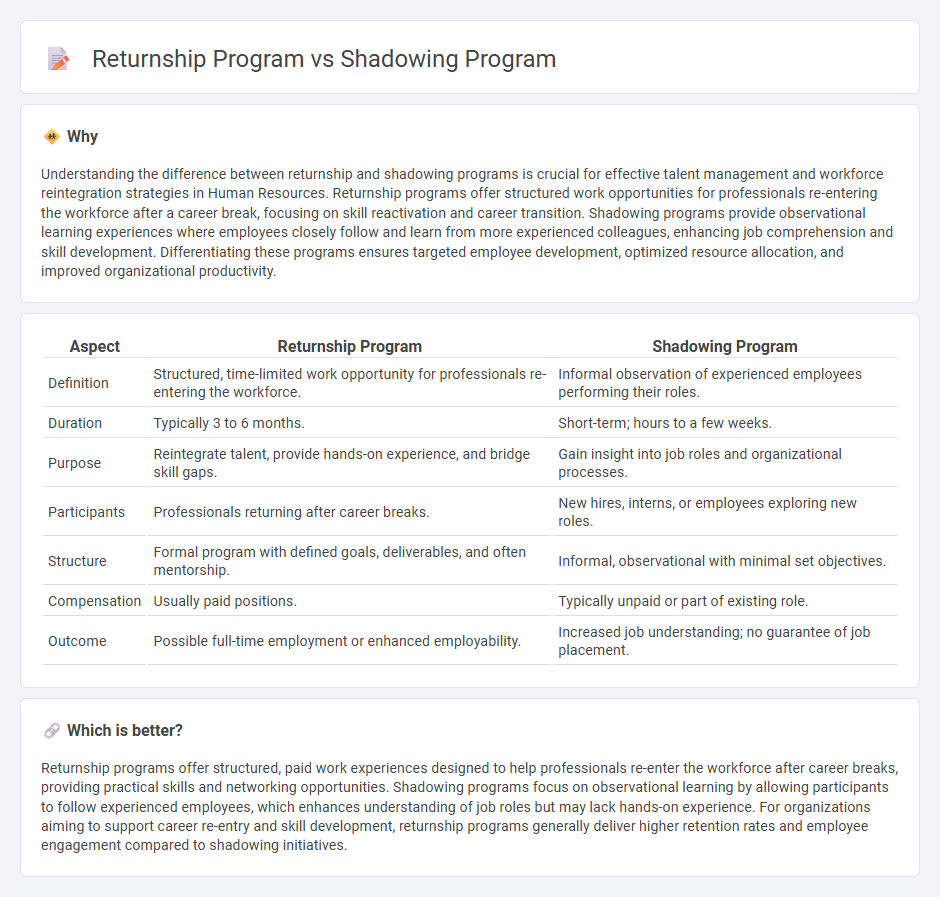
Returnship programs provide experienced professionals an opportunity to re-enter the workforce after a career break by offering structured roles and skill refreshment. Shadowing programs enable employees to observe and learn from colleagues in different positions, fostering skill development and cross-functional understanding. Explore how these programs can enhance talent acquisition and employee growth strategies.
Why it is important
Understanding the difference between returnship and shadowing programs is crucial for effective talent management and workforce reintegration strategies in Human Resources. Returnship programs offer structured work opportunities for professionals re-entering the workforce after a career break, focusing on skill reactivation and career transition. Shadowing programs provide observational learning experiences where employees closely follow and learn from more experienced colleagues, enhancing job comprehension and skill development. Differentiating these programs ensures targeted employee development, optimized resource allocation, and improved organizational productivity.
Comparison Table
| Aspect | Returnship Program | Shadowing Program |
|---|---|---|
| Definition | Structured, time-limited work opportunity for professionals re-entering the workforce. | Informal observation of experienced employees performing their roles. |
| Duration | Typically 3 to 6 months. | Short-term; hours to a few weeks. |
| Purpose | Reintegrate talent, provide hands-on experience, and bridge skill gaps. | Gain insight into job roles and organizational processes. |
| Participants | Professionals returning after career breaks. | New hires, interns, or employees exploring new roles. |
| Structure | Formal program with defined goals, deliverables, and often mentorship. | Informal, observational with minimal set objectives. |
| Compensation | Usually paid positions. | Typically unpaid or part of existing role. |
| Outcome | Possible full-time employment or enhanced employability. | Increased job understanding; no guarantee of job placement. |
Which is better?
Returnship programs offer structured, paid work experiences designed to help professionals re-enter the workforce after career breaks, providing practical skills and networking opportunities. Shadowing programs focus on observational learning by allowing participants to follow experienced employees, which enhances understanding of job roles but may lack hands-on experience. For organizations aiming to support career re-entry and skill development, returnship programs generally deliver higher retention rates and employee engagement compared to shadowing initiatives.
Connection
Returnship programs and shadowing programs are interconnected as both provide structured opportunities for employees to reintegrate into the workforce or transition into new roles through experiential learning. Returnship programs focus on professionals re-entering the job market after a career break, often incorporating shadowing as a key component for hands-on experience and skill reacquisition. Shadowing programs enhance returnship outcomes by allowing participants to observe and learn from experienced colleagues, accelerating knowledge transfer and building confidence in workplace competencies.
Key Terms
**Shadowing Program:**
Shadowing programs provide employees or students the opportunity to observe experienced professionals in their daily roles, enhancing practical understanding and skill development through direct exposure. These programs emphasize passive learning by following mentors closely, offering real-world insights without immediate hands-on responsibilities. Discover how shadowing programs can accelerate career growth and skill acquisition in your field.
Observation
Shadowing programs provide participants with direct observation opportunities to learn job roles by watching experienced professionals in real time, enhancing practical understanding without immediate hands-on responsibilities. Returnship programs combine observation with active project involvement, targeting professionals re-entering the workforce to rebuild skills through structured mentorship and work experience. Explore the unique benefits of observation in both programs to determine which suits your career goals best.
Mentor
Mentor roles in shadowing programs emphasize observational learning, allowing mentees to gain insights by closely following experienced professionals during their daily tasks. In returnship programs, mentors provide structured guidance, skill development, and networking opportunities to support career re-entry for professionals after a career break. Explore how mentor involvement shapes the success of both programs and drives professional growth.
Source and External Links
Building a Job Shadowing Program - This article discusses the benefits and steps to create a job shadowing program for employers and employees, enhancing mentorship and skill development.
Clinical Shadowing - Offers virtual and interactive clinical shadowing experiences, providing aspiring health professionals with real-world medical observation and learning opportunities.
Career Treks Job Shadowing Program - Assists students in exploring career fields by offering a structured job shadowing experience involving workplace tours, observation, and hands-on projects.
 dowidth.com
dowidth.com